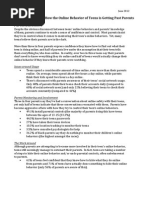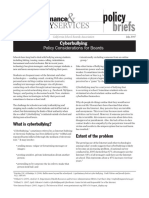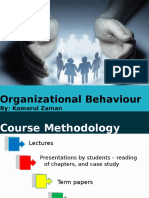Infographic Electronic Bullying
Infographic Electronic Bullying
Uploaded by
api-336432282Copyright:
Available Formats
Infographic Electronic Bullying
Infographic Electronic Bullying
Uploaded by
api-336432282Original Title
Copyright
Available Formats
Share this document
Did you find this document useful?
Is this content inappropriate?
Copyright:
Available Formats
Infographic Electronic Bullying
Infographic Electronic Bullying
Uploaded by
api-336432282Copyright:
Available Formats
Online Peer Intervention
Young Canadians Experiences with Electronic Bullying
Methodology
800 respondents answered the survey based on their experiences in the previous 4 weeks
53% Female
46% Male
1% Other
80% English
20% French
46% Age 12-15
Twelve
54% Age 16-18
Thirteen
Fourteen
Fifteen
ON
Sixteen
Seventeen
QC
Eighteen
BC
AB MB NS SK NB NL PE NU NT
Key Findings
Boys were significantly more likely than girls
to experience electronic bullying
Boys were also significantly more likely than
girls to say they had electronically bullied
45%
38%
Boys
Girls
42% of youth experienced
electronic bullying at least once in
the previous four weeks
Girls
Older youth were significantly more likely than
younger youth to experience electronic bullying
47% of 17- to 18-year-olds
36% of 12- to 14-year-olds
60% of youth witnessed
electronically bullying in the
previous four weeks
Youth who are victimized online
were more likely to bully online
32% of bullied youth said
they had bullied others at least
once in the previous four weeks
17%
12%
Boys
Youth who identified as a member
of a racial or ethnic minority
reported higher levels of both experiencing
and perpetrating electronic bullying in the
previous four weeks
Intervening
71
Highest rated
intervention strategies
of those who saw electronic
bullying did something to
intervene at least once
comfort
the target privately
tell
Respondents willingness to
intervene was not affected
by their gender or age
a trusted adult
talk
Youth are very protective of family
about how to handle it
with parents and/or friends
Their likelihood of intervening when the target is:
90%
89%
82%
Family member
Close friend
Dating partner
Student at school
Stranger
Lowest rated
intervention strategies
Read it and
do nothing
62%
or laugh at it
37%
Motivations and Barriers
What would make youth more likely to intervene?
87%
85%
81%
If the electronic bullying was clearly wrong
If they knew intervening would make a difference
If they could intervene anonymously
What worries prevent youth from intervening?
67%
Worry they will turn themselves into targets
Worry it will make things worse for the target
53%
Role of Adults
Youth are not fully convinced that adults will be helpful
33
of youth do not intervene because
they think adults do not give advice
that helps
43
of youth agree that talking to
parents and teachers
will not change anything
However, the #2 and #3 top-rated intervention strategies
involved talking to adults:
Tell a trusted adult
Talk about how to handle it with parents
74%
73%
Adults need to be provided with the right tools and resources to empower
youth to stand up to electronic bullying. Visit telus.com/wise to download
family-friendly electronic bullying resources and to access the full report.
You might also like
- 09 Fraud, Error and Non-ComplianceDocument5 pages09 Fraud, Error and Non-ComplianceEdwina Cornel100% (1)
- Position PaperDocument1 pagePosition PaperJulia Kirsty JaliqueNo ratings yet
- The Digital Divide: How The Online Behavior of Teens Is Getting Past ParentsDocument5 pagesThe Digital Divide: How The Online Behavior of Teens Is Getting Past ParentsLeoNo ratings yet
- ADAF Directory Resources International Food Revised20041Document102 pagesADAF Directory Resources International Food Revised20041Raquel CavacoNo ratings yet
- Cyber Bullying and StalkingDocument11 pagesCyber Bullying and Stalkingapi-287711710No ratings yet
- No Place To HideDocument8 pagesNo Place To HideMa ZaNo ratings yet
- Dont Give Up On Us Childrens SurveyDocument8 pagesDont Give Up On Us Childrens SurveyBlackpool Community News at Scribd100% (1)
- 1 FriendshipsDocument5 pages1 FriendshipsMbalentle ManyontaNo ratings yet
- SexTech Summary PDFDocument20 pagesSexTech Summary PDFmatildameisterNo ratings yet
- Case Fa4Document4 pagesCase Fa4Domex Toilet CleanerNo ratings yet
- Official BookcannyDocument21 pagesOfficial Bookcannyapi-263848390No ratings yet
- Study Results: Civility in B.C.Document6 pagesStudy Results: Civility in B.C.The Vancouver SunNo ratings yet
- Teens and Cyberbullying 2022 - Pew Research CenterDocument14 pagesTeens and Cyberbullying 2022 - Pew Research CenterNguyễn Thị Tú OanhNo ratings yet
- Cyber Bullying Outline by Cliff AkiyamaDocument6 pagesCyber Bullying Outline by Cliff Akiyamatimtomtim50% (1)
- Cyberbullying FactsDocument6 pagesCyberbullying FactsMaria Margaret MacasaetNo ratings yet
- Argumentative EssayDocument4 pagesArgumentative Essayapi-486762069No ratings yet
- Teens, Technology & Friendship Author Amanda Lenhart, Aaron Smith, Monica Anderson, Maeve Duggan and Andrew PerrinDocument76 pagesTeens, Technology & Friendship Author Amanda Lenhart, Aaron Smith, Monica Anderson, Maeve Duggan and Andrew PerrinDavidNo ratings yet
- Survey ResultsDocument4 pagesSurvey Resultsapi-298754216No ratings yet
- Adolescent Internet UseDocument7 pagesAdolescent Internet UseMissPreglerNo ratings yet
- Official BookDocument21 pagesOfficial Bookapi-263705067No ratings yet
- Parenting 2.0: Help Parents With Digital Issues and Fears ERev2015Document63 pagesParenting 2.0: Help Parents With Digital Issues and Fears ERev2015Rita OatesNo ratings yet
- LINA High School Edition - Approved 2.12.14 PDFDocument93 pagesLINA High School Edition - Approved 2.12.14 PDFFlorenciaAnabellaFleitasNo ratings yet
- Pakistan Internet Use Survey 2013Document23 pagesPakistan Internet Use Survey 2013expresstribune100% (2)
- Social Media and BullyingDocument23 pagesSocial Media and Bullyingapi-242602723No ratings yet
- Chapter 4 - Social Media and FriendshipsDocument14 pagesChapter 4 - Social Media and FriendshipsDestiny RichterNo ratings yet
- Bullying SpeechDocument5 pagesBullying Speechapi-341764450No ratings yet
- Social Media and Teen Friendships - Pew Research CenterDocument13 pagesSocial Media and Teen Friendships - Pew Research CenterBea SibayanNo ratings yet
- Youth and YA Survey Results 4-3-14Document3 pagesYouth and YA Survey Results 4-3-14heidigrooverNo ratings yet
- Elder-Abuse-The Indian-Youth-Speaks-OutDocument48 pagesElder-Abuse-The Indian-Youth-Speaks-OutSudhit SethiNo ratings yet
- Teenage Relationships: PsychologyDocument22 pagesTeenage Relationships: Psychologydark_sorrowsNo ratings yet
- PIP Schools ReportDocument10 pagesPIP Schools ReportMaja BungićNo ratings yet
- Teen Age Violence MatthewDocument2 pagesTeen Age Violence Matthewapi-335730071No ratings yet
- 2011-2016 National Youth Assessmen (PDF Format)Document9 pages2011-2016 National Youth Assessmen (PDF Format)Marly EspirituNo ratings yet
- Chapter 5: Con Ict, Friendships and TechnologyDocument6 pagesChapter 5: Con Ict, Friendships and TechnologyCheskaGarciaNo ratings yet
- Article Writing - EditedDocument3 pagesArticle Writing - EditedAthman MwajmaNo ratings yet
- Taken Out of Carib IADocument16 pagesTaken Out of Carib IAEmmanuel ChichesterNo ratings yet
- Cyber BullyingDocument1 pageCyber Bullyingapi-286294631No ratings yet
- Social MediaDocument13 pagesSocial MediaMark Alvin De LeonNo ratings yet
- CyberbullyingDocument6 pagesCyberbullyingapi-306195061No ratings yet
- Cyberbullying For StudentsDocument9 pagesCyberbullying For Studentsapi-269410881No ratings yet
- You Can Find More Information At:: Million Reports of Child Abuse Are Made in The United States InvolvingDocument2 pagesYou Can Find More Information At:: Million Reports of Child Abuse Are Made in The United States InvolvingAlexandruTapirdeaNo ratings yet
- Where Teens Seek Online Privacy AdviceDocument17 pagesWhere Teens Seek Online Privacy AdviceBinkee VillaramaNo ratings yet
- PIP Teens Social Media Final PDFDocument44 pagesPIP Teens Social Media Final PDFSwÏng Talunay TabordaNo ratings yet
- Kolej Matrikulasi Negeri Sembilan SESSION 2012/2013 Title:Teenagers and GenerosityDocument25 pagesKolej Matrikulasi Negeri Sembilan SESSION 2012/2013 Title:Teenagers and GenerosityJaya ShriNo ratings yet
- Κλοπή διαδικτυακής ΤαυτότηταςDocument17 pagesΚλοπή διαδικτυακής ΤαυτότηταςANDREASNo ratings yet
- Interview Analysis - Last Draft With FindingsDocument4 pagesInterview Analysis - Last Draft With FindingsHermioneNo ratings yet
- 11 and Below 7% 18 and Above 3%Document11 pages11 and Below 7% 18 and Above 3%Eve VillasantaNo ratings yet
- Safe Text: Protecting Your Teen From the Dangers of TextingFrom EverandSafe Text: Protecting Your Teen From the Dangers of TextingRating: 5 out of 5 stars5/5 (1)
- Decision of Marry - Cause and Effect of Early Marriage PDFDocument5 pagesDecision of Marry - Cause and Effect of Early Marriage PDFMafatichul FaaulinaNo ratings yet
- Childrens Media Use and Attitudes Report 2022Document80 pagesChildrens Media Use and Attitudes Report 2022Adrian B.No ratings yet
- 2015 Healthy Kids Colorado Survey SummaryDocument4 pages2015 Healthy Kids Colorado Survey SummaryEagle River YouthNo ratings yet
- Effect of Social Media On YouthDocument15 pagesEffect of Social Media On YouthPavan KumarNo ratings yet
- Sample Science NewsDocument1 pageSample Science NewsCrissPerssonNo ratings yet
- Survey by AARP - Online Relationship ScamsDocument31 pagesSurvey by AARP - Online Relationship ScamspatNo ratings yet
- Boys White PaperDocument12 pagesBoys White PaperflorenceNo ratings yet
- Social Media and Its Effects On YouthDocument4 pagesSocial Media and Its Effects On YouthKumar SagarNo ratings yet
- Noys National Organizations For Youth Safety Stop Bully ToolkitDocument34 pagesNoys National Organizations For Youth Safety Stop Bully ToolkitSean RamseyNo ratings yet
- Bam Presentation Final 2007 Qual & QuantDocument197 pagesBam Presentation Final 2007 Qual & Quantapi-3714126No ratings yet
- Online Dating Game for Senior Citizens: Get Back Into the Dating SceneFrom EverandOnline Dating Game for Senior Citizens: Get Back Into the Dating SceneNo ratings yet
- Ascites: Other Associated FeaturesDocument8 pagesAscites: Other Associated FeaturesumasdeviNo ratings yet
- Introduction To Open Data CertificatesDocument26 pagesIntroduction To Open Data CertificatesOpen Data Institute100% (3)
- Final Lesson Choral PresentationsDocument4 pagesFinal Lesson Choral PresentationsJeremy BasilioNo ratings yet
- Guillermin Library Liberty University Lynchburg, VA 24502Document550 pagesGuillermin Library Liberty University Lynchburg, VA 24502Mark AggreyNo ratings yet
- Literature Review NirmaDocument3 pagesLiterature Review NirmaVicky Patel100% (4)
- Computer Simulation of Induction HeatingDocument4 pagesComputer Simulation of Induction HeatingvertauldNo ratings yet
- GAP Model On Mac Donald's: Presented by Group No: 3Document20 pagesGAP Model On Mac Donald's: Presented by Group No: 3Dipesh KotechaNo ratings yet
- Uber-Waymo Page Deposition Ruling 7:10:17Document3 pagesUber-Waymo Page Deposition Ruling 7:10:17CNET NewsNo ratings yet
- The Passive: Context Listemn EiDocument6 pagesThe Passive: Context Listemn EiDavid OrtegaNo ratings yet
- Quanta Geo BRDocument28 pagesQuanta Geo BRsardarNo ratings yet
- 2010-The Future of STEM EducationDocument4 pages2010-The Future of STEM EducationdianNo ratings yet
- Sarah Loomis Page 1 of 20Document20 pagesSarah Loomis Page 1 of 20Sarah LoomisNo ratings yet
- Jti - Rfic NotesDocument2 pagesJti - Rfic NotesmuralikrishnavNo ratings yet
- El Amor BrujoDocument17 pagesEl Amor BrujoEzra Mikah G. CaalimNo ratings yet
- Criminology, Law, and Justice (CLJ) : CoursesDocument2 pagesCriminology, Law, and Justice (CLJ) : CoursesJane Rose AlejadoNo ratings yet
- Cayetano vs. LeonidasDocument7 pagesCayetano vs. LeonidasJeng PionNo ratings yet
- Earthquake Analysis and Design of StructuralDocument15 pagesEarthquake Analysis and Design of StructuralNarayanan Moorthy100% (2)
- catalog_FlowerMed_june 2023Document19 pagescatalog_FlowerMed_june 2023pedroboveescritorNo ratings yet
- Is GPS 200K PDFDocument219 pagesIs GPS 200K PDFMack KnifeNo ratings yet
- CAREW, T. J. - Startle Circuits - Neural Mechanisms of Startle Behavior. (1985) (10.1126 - Science.229.4709.158) - Libgen - LiDocument2 pagesCAREW, T. J. - Startle Circuits - Neural Mechanisms of Startle Behavior. (1985) (10.1126 - Science.229.4709.158) - Libgen - LinajiNo ratings yet
- A Short History of Indian LiteratureDocument225 pagesA Short History of Indian Literaturenrk1962No ratings yet
- Book Review Assignment InstructionsDocument2 pagesBook Review Assignment Instructionsbramkonyino78No ratings yet
- Limits, Fits, Tolerances and Gauges: Abinash DasDocument78 pagesLimits, Fits, Tolerances and Gauges: Abinash DasAbinash DasNo ratings yet
- HUMA1950SU 2023 SyllabusDocument11 pagesHUMA1950SU 2023 SyllabusHumza T kingNo ratings yet
- Organizational BehaviourDocument69 pagesOrganizational BehaviourKALBE ABD GHANI100% (2)
- AR 2018 Full PDFDocument222 pagesAR 2018 Full PDFRaymondNo ratings yet
- On Tamil MilitarismDocument76 pagesOn Tamil MilitarismSharmalan ThevarNo ratings yet
- Practice Paper1 - Grade 11 - English Literature - QPDocument5 pagesPractice Paper1 - Grade 11 - English Literature - QPjhaashish08.06.07No ratings yet

























































































